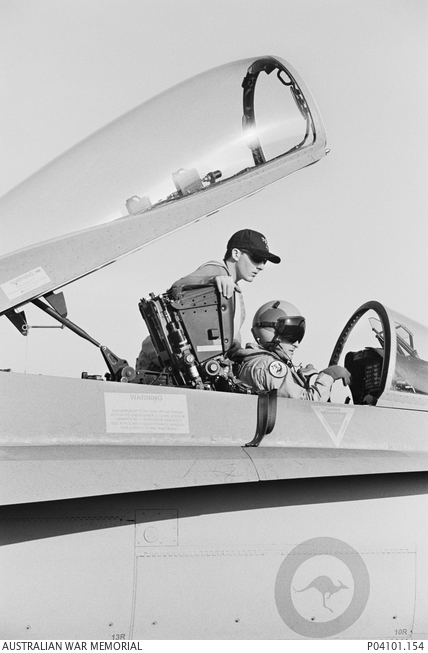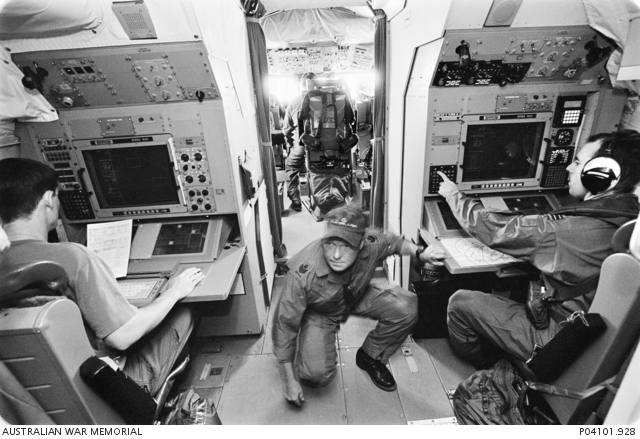Australians in Iraq 2003: The RAAF in Iraq
- War in Iraq
- Political debate at home
- The RAN in the Persian Gulf
- RAN clearance divers
- The SAS in Iraq
- Special forces group
- The RAAF in Iraq
- Australians in Baghdad
- Current situation
- Official war artists
The RAAF in Iraq
Fourteen F/A-18 Hornet aircraft from 75 Squadron played a significant role in the war in Iraq. The Hornets were based at Al Udeid air base, near Doha in Qatar. At first they flew long missions of five or six hours, escorting and protecting coalition early warning AWACS aircraft and tanker aircraft used for air-to-air refuelling. Later, at the height of the war, the Hornets were used to attack Iraqi ground forces with laser-guided bombs. Targets included tanks, trucks, and artillery, as well as bunkers and storage areas for fuel and ammunition. As Iraqi resistance crumbled, the Hornets also flew close air-support missions to assist Australian and other troops on the ground as they advanced on Tikrit, north of Baghdad, a centre of support for the regime.
The RAAF also sent two P-3 Orion maritime patrol aircraft and three C-130 Hercules transport aircraft to the Middle East. The Orions typically flew long 12-hour missions, especially at night, over the Persian Gulf. They assisted naval operations in the Gulf by keeping track of the large number of small vessels in the area, both to curb smuggling and to guard against the danger that they could be suicide boats packed with explosives. As the war went on, the versatile Hercules flew supplies and equipment into Iraq, and later flew some of the first humanitarian aid into Baghdad.
F-16, Al Udeid airbase, Qatar
Lewis Miller, Second Gulf War, official war artist
A US Air Force F-16 Fighting Falcon aircraft at its base in the Middle East.
Members of 75 Squadron prepare an F/A-18 Hornet aircraft for a training flight over their base in the Middle East in April or May 2003. Seated in the cockpit is Flight Lieutenant Peter Weekes.
The crew of an RAAF P-3 Orion maritime surveillance aircraft conduct pre-flight tests as they prepare for take-off from their base in the Middle East in April or May 2003. The Orions typically flew long missions often of 12 hours over the waters of the Persian Gulf.
F/A-18 Hornet aircraft of 75 Squadron, 27 April 2003.
An F/A-18 Hornet aircraft of 75 Squadron taxiing at its base in Qatar on 27 April 2003. Fourteen RAAF Hornets flew over 670 sorties during the war, including 350 combat sorties over Iraq.
Hornet pilots waiting to fly their last mission of the war
David Dare Parker
Members of 75 Squadron wait on the tarmac before flying their last combat mission of the war, on 27 April 2003.
An RAAF P-3C Orion maritime patrol aircraft on the tarmac in the Middle East, in April or May 2003. The Orion is powered by four Allison T56 turboprop engines and has a maximum speed of 660 kilometres per hour
Members of an AP-3C Orion maritime surveillance aircraft crew use sophisticated electronic equipment to monitor water-borne traffic in the Persian Gulf. An important task for the Orions was to keep track of small craft, which could be either smugglers’ or suicide boats.







